by Jason Bodner
June 18, 2024
I picked the wrong profession, or at least the wrong place to practice it.
Wall Street was intense. I made good money and had a great lifestyle. But there were heavy sacrifices. Sometimes the stress was unimaginably high. It affected my health seriously at one point. The worst part about Wall Street was the anxiety. There was constant worry about everything. We worried about the bad and good. We worried about the next shoe to drop. We worried when there was nothing to worry about.
That’s no way to live, so I left Wall Street and decided to focus more on the moments I have rather than worrying about the events that might never come. In the process, I stumbled onto something… Studies show that people finding pleasure in the moment are happier than those who ruminate on the past or worry about the future. Enjoying simple pleasures makes for happier and more productive people.
In short, everything is going to be fine. Case in point: Going into mid-April, anxiety was high over Q1 earnings reports. Well, the total tallies are in. According to FactSet, with nearly all S&P 500 companies reporting, 78% beat EPS estimates and 59% beat revenue estimates. Every sector looks good in terms of earnings and most look good in terms of revenues. (In the following charts, green is “above estimates”).
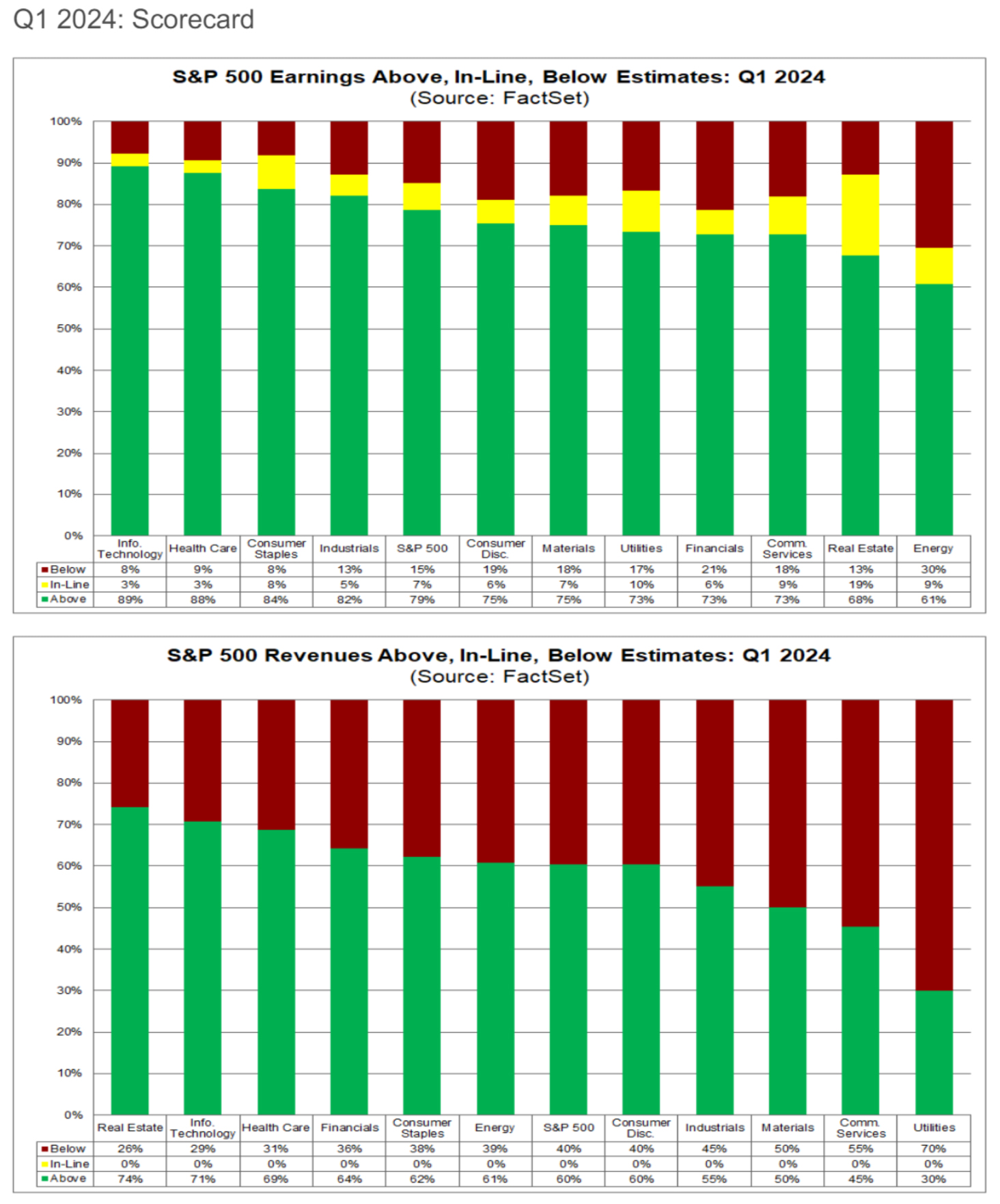
Graphs are for illustrative and discussion purposes only. Please read important disclosures at the end of this commentary.
I expected this and even said so… On April 14th, before hardly any reports were in, I wrote:
“Upcoming earnings for Q1 will likely fit the same pattern. My guess based on history is that 79% of companies will beat earnings estimates and 67% will beat sales estimates.”
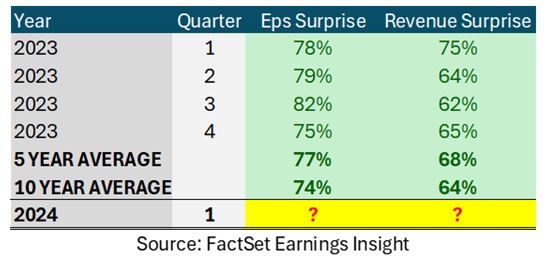
Graphs are for illustrative and discussion purposes only. Please read important disclosures at the end of this commentary.
With all the facts in hand, let’s complete that chart:
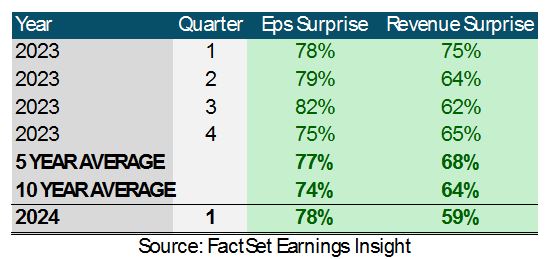
Graphs are for illustrative and discussion purposes only. Please read important disclosures at the end of this commentary.
While revenues are slightly lower than predicted, due to Utilities and Communications lagging, earnings are great. The bigger picture is the 10-year average, which shows we shouldn’t worry about earnings.
Investors also worried last October, when markets were low, but a 33% rally of SPY (S&P 500 tracking ETF) showed fears were unfounded. Then came another worry point in April, when things got bumpy:
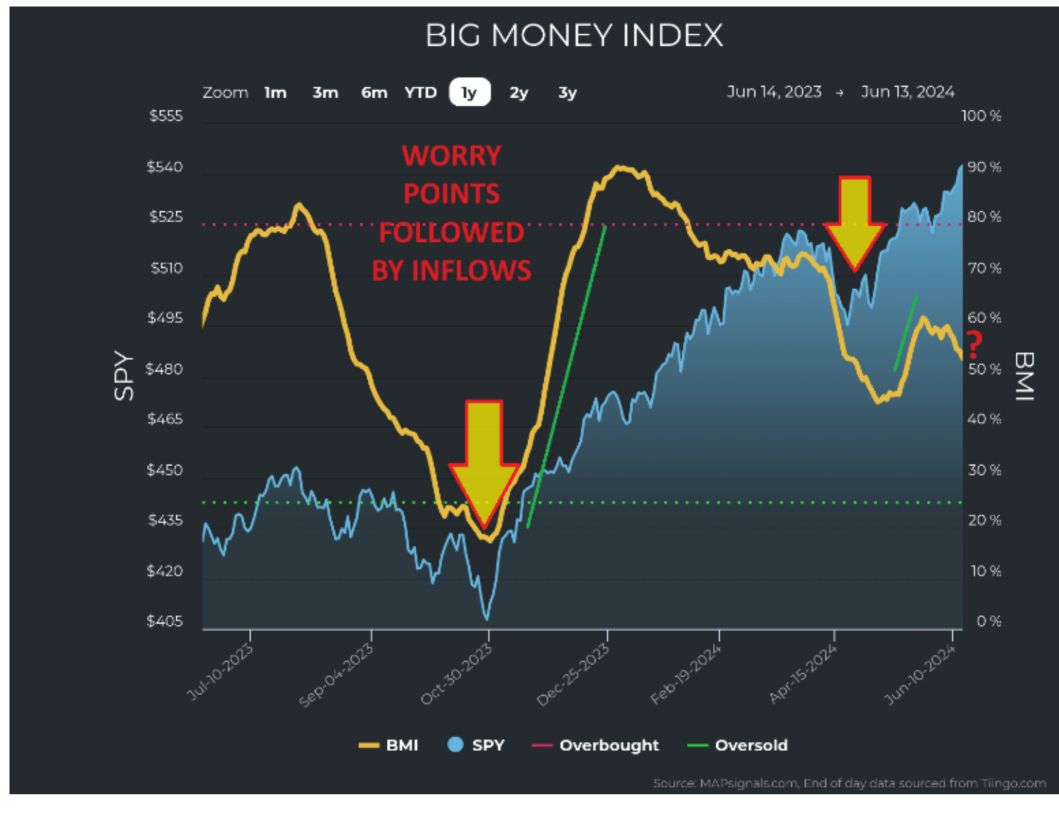
Graphs are for illustrative and discussion purposes only. Please read important disclosures at the end of this commentary.
My red “?” mark off to the right is our collective worry returning. What’s next? Will things get worse? What will the election bring? What about the Middle East? Ukraine? Global warming? Inflation?
It never ends. While we can use history as a rough guide to the future, all we can really do is live in the moment. For now, the weather is calm. The breeze just died down. The Big Money Index (BMI) is falling, due to slower buying, but selling has not increased either; In fact, selling is shrinking, which means calm seas with no wind. We can see that in the charts of unusual buying and selling.
The stocks chart (left) shows a tightening coil while the ETF chart (right) shows hardly any action at all:
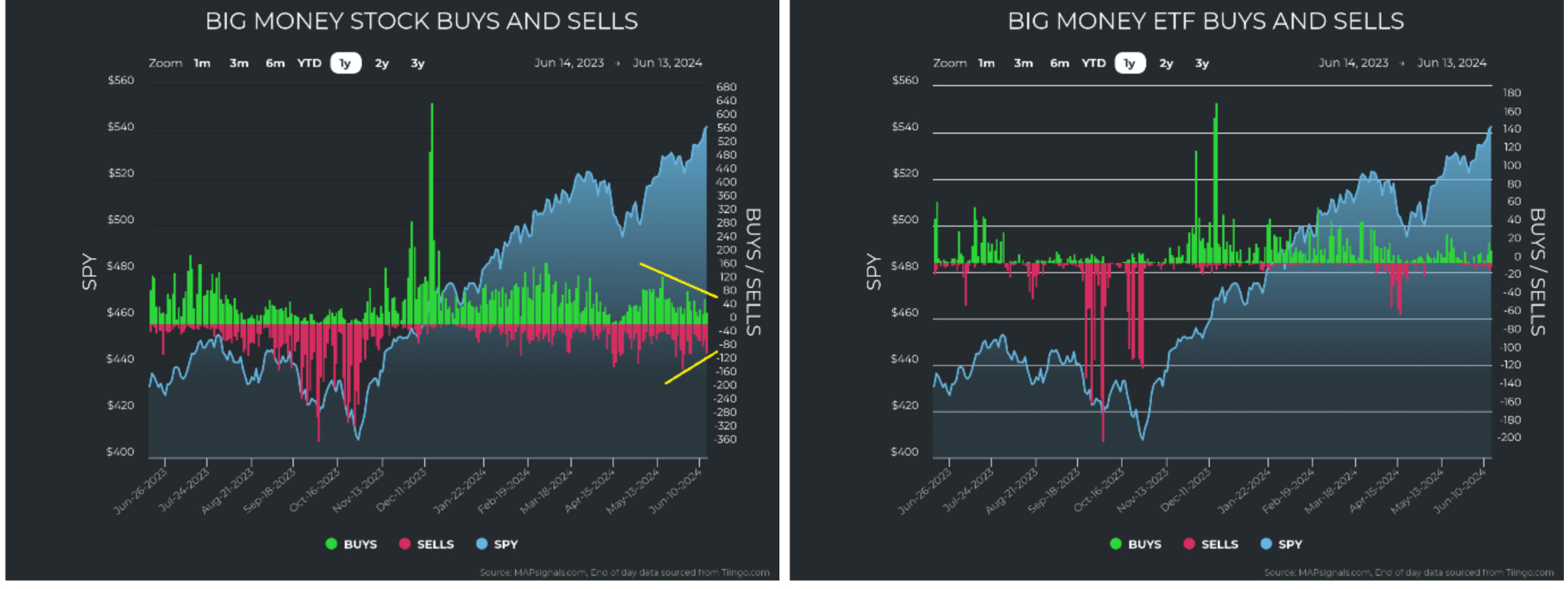
Graphs are for illustrative and discussion purposes only. Please read important disclosures at the end of this commentary.
This means things could go either way… Stocks could pause and charge higher, or they could reverse and go lower. History says that a “mixed” June is common, while July has been kinder to investors, historically. August and September are usually weak, followed by a great fourth quarter.
The following chart shows monthly market returns for four indexes from 1990 through 2023:
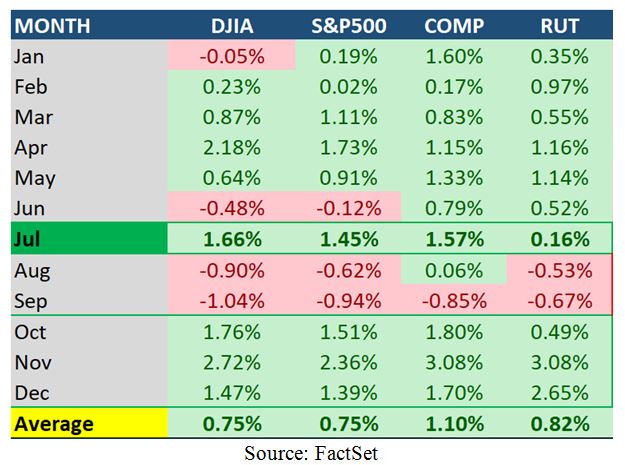
Graphs are for illustrative and discussion purposes only. Please read important disclosures at the end of this commentary.
Maybe the July row of returns can alleviate some anxiety over what might be, but let’s focus on what is. One thing I really like seeing is that Technology is the leading sector again. Discretionary is also slowly making its way up the rankings. When these two sectors are at the top of the rankings, it signifies a strong, vibrant economy with a healthy consumer. Pay special heed to the fundamental scores of the sectors; we don’t want just technically strong sectors. That could mean a reversion lower if fundamentals don’t catch up. We want sectors that are growing their sales, earnings and profits. The strongest fundamental sectors now are Technology, Industrials, Energy, and Discretionary. That’s good news.
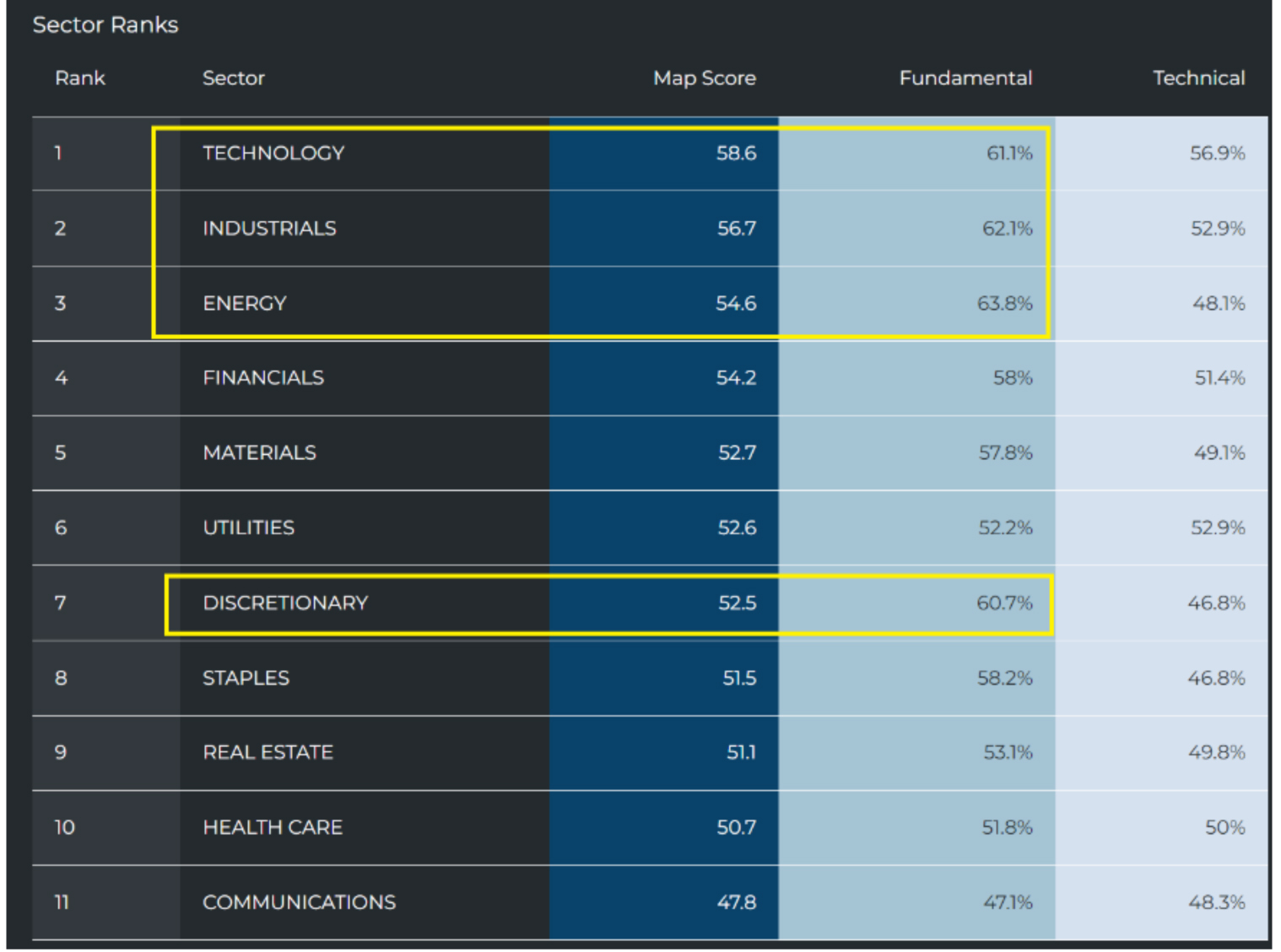
Graphs are for illustrative and discussion purposes only. Please read important disclosures at the end of this commentary.
Looking further into the sectors, we see similar action in terms of unusual buying and selling. This makes sense, as all sectors comprise the market. Buying grew in Tech after a bout of nasty selling. That’s constructive. Looking at each sector, the main theme is that both buying and selling are waning:
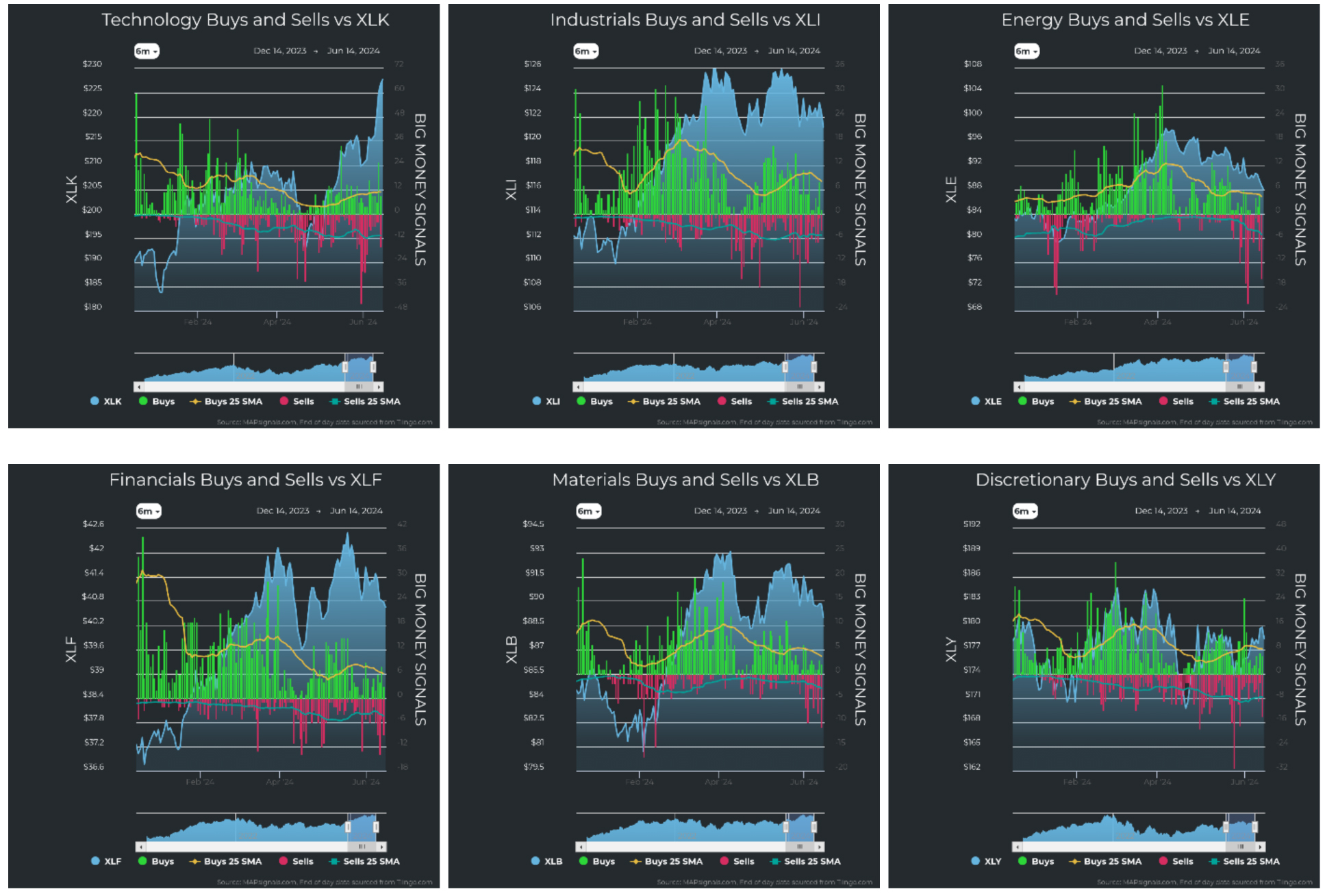
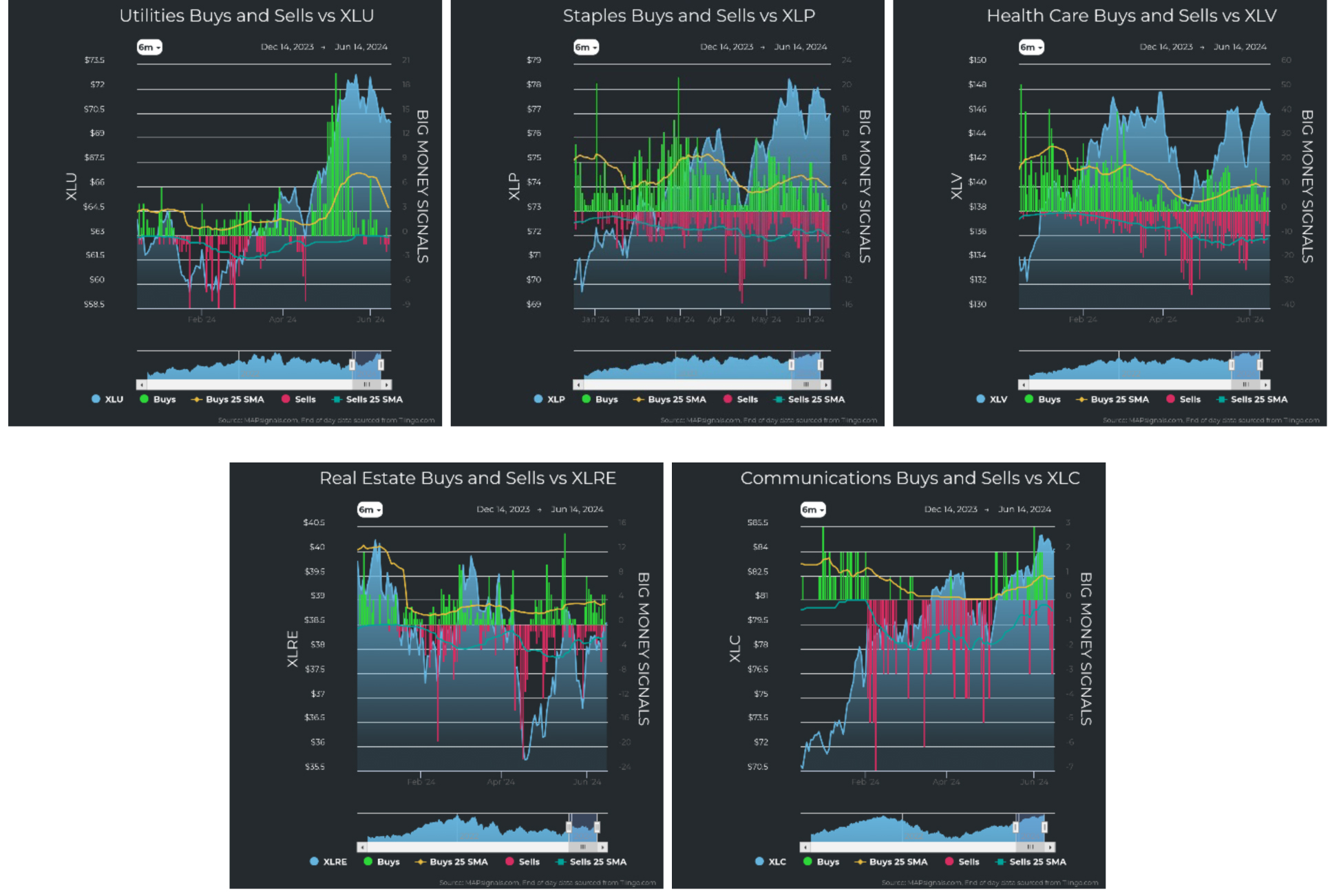
Graphs are for illustrative and discussion purposes only. Please read important disclosures at the end of this commentary.
Again, this could mean that we should prepare for more volatility, but history says that we might expect a nice July followed by an ugly August and September.
So, if we’re better off trying to live in the moment, what do we do now?
I’ll tell you what I am doing: I am “on vacation,” but I am also looking through market trends to identify great stocks. I’m in Spain and Portugal. I have been to four cities in the last 10 days. The streets are packed, the restaurants are full, the hotels are booked, and the flights here and back were oversold.
That tells me the travel and leisure market is vibrant right now, so I went on a deep dive into stocks in travel and leisure to see what scores well in terms of the fundamentals and technicals.
I filtered the Consumer Discretionary sector stocks focusing on Hospitality. Out of those 121 stocks, I filtered down the list to find those that have a MAPscore of 60 or higher and found 20 stocks. Among those 20, the top six were: Royal Caribbean Group (RCL), MakeMyTrip, Inc. (MMYT), Texas Roadhouse, Inc. (TXRH), Despegar.com (DESP), Chipotle Mexican Grill, Inc. (CMG) and Booking Holdings, Inc (BKNG), the last two of which I own. Also on the top 20 list is AirBnB (ABNB), which is very interesting to me since I have a family of five. That requires two hotel rooms and lots of laundry. It’s a challenge to rent an apartment where every child has their own bed, and we can do laundry. Good hosts are like concierges who give recommendations for local attractions and dining. We use AirBnB for trips and it’s great. It has low technicals, as it pulled back from a high, but it has terrific fundamentals.
Instead of worrying about what will be, we should focus on what is. Markets will do what they do; we have tools to help us navigate. When uncertainty strikes, focus on the now and find opportunity within.
Charles Kuralt had a long and decorated career with CBS News. He died in 1997 but not before he could share his wisdom at my graduation ceremony. In his speech there, he said: “Life is not a dress rehearsal.”
He was right.
Navellier & Associates owns Royal Caribbean Group (RCL), MakeMyTrip, Inc. (MMYT), Chipotle Mexican Grill, Inc. (CMG) and Booking Holdings, Inc (BKNG), in managed accounts. We do not own AirBnB (ABNB), Texas Roadhouse, Inc. (TXRH), and Despegar.com (DESP), in managed accounts. Jason Bodner owns Chipotle Mexican Grill, Inc. (CMG) and Booking Holdings, Inc (BKNG), in a personal account. He does not own AirBnB (ABNB), Royal Caribbean Group (RCL), MakeMyTrip, Inc. (MMYT), Texas Roadhouse, Inc. (TXRH), Despegar.com (DESP), personally.
All content above represents the opinion of Jason Bodner of Navellier & Associates, Inc.
Also In This Issue
A Look Ahead by Louis Navellier
Powell Needs to Face Reality – and Take Control
Income Mail by Bryan Perry
The Market Just Got Real Simple, Real Fast, For Most Investors
Growth Mail by Gary Alexander
The Data-Dependent Fed Relies on Deceptive Data to Meet its Misleading Mandates
Global Mail by Ivan Martchev
Beware the Franco-German Spread
Sector Spotlight by Jason Bodner
While in Europe, I Take a Closer Look at Travel & Leisure Stocks
View Full Archive
Read Past Issues Here

Jason Bodner
MARKETMAIL EDITOR FOR SECTOR SPOTLIGHT
Jason Bodner writes Sector Spotlight in the weekly Marketmail publication and has authored several white papers for the company. He is also Co-Founder of Macro Analytics for Professionals which produces proprietary equity accumulation/distribution research for its clients. Previously, Mr. Bodner served as Director of European Equity Derivatives for Cantor Fitzgerald Europe in London, then moved to the role of Head of Equity Derivatives North America for the same company in New York. He also served as S.V.P. Equity Derivatives for Jefferies, LLC. He received a B.S. in business administration in 1996, with honors, from Skidmore College as a member of the Periclean Honors Society. All content of “Sector Spotlight” represents the opinion of Jason Bodner
Important Disclosures:
Jason Bodner is a co-founder and co-owner of Mapsignals. Mr. Bodner is an independent contractor who is occasionally hired by Navellier & Associates to write an article and or provide opinions for possible use in articles that appear in Navellier & Associates weekly Market Mail. Mr. Bodner is not employed or affiliated with Louis Navellier, Navellier & Associates, Inc., or any other Navellier owned entity. The opinions and statements made here are those of Mr. Bodner and not necessarily those of any other persons or entities. This is not an endorsement, or solicitation or testimonial or investment advice regarding the BMI Index or any statements or recommendations or analysis in the article or the BMI Index or Mapsignals or its products or strategies.
Although information in these reports has been obtained from and is based upon sources that Navellier believes to be reliable, Navellier does not guarantee its accuracy and it may be incomplete or condensed. All opinions and estimates constitute Navellier’s judgment as of the date the report was created and are subject to change without notice. These reports are for informational purposes only and are not a solicitation for the purchase or sale of a security. Any decision to purchase securities mentioned in these reports must take into account existing public information on such securities or any registered prospectus.To the extent permitted by law, neither Navellier & Associates, Inc., nor any of its affiliates, agents, or service providers assumes any liability or responsibility nor owes any duty of care for any consequences of any person acting or refraining to act in reliance on the information contained in this communication or for any decision based on it.
Past performance is no indication of future results. Investment in securities involves significant risk and has the potential for partial or complete loss of funds invested. It should not be assumed that any securities recommendations made by Navellier. in the future will be profitable or equal the performance of securities made in this report. Dividend payments are not guaranteed. The amount of a dividend payment, if any, can vary over time and issuers may reduce dividends paid on securities in the event of a recession or adverse event affecting a specific industry or issuer.
None of the stock information, data, and company information presented herein constitutes a recommendation by Navellier or a solicitation to buy or sell any securities. Any specific securities identified and described do not represent all of the securities purchased, sold, or recommended for advisory clients. The holdings identified do not represent all of the securities purchased, sold, or recommended for advisory clients and the reader should not assume that investments in the securities identified and discussed were or will be profitable.
Information presented is general information that does not take into account your individual circumstances, financial situation, or needs, nor does it present a personalized recommendation to you. Individual stocks presented may not be suitable for every investor. Investment in securities involves significant risk and has the potential for partial or complete loss of funds invested. Investment in fixed income securities has the potential for the investment return and principal value of an investment to fluctuate so that an investor’s holdings, when redeemed, may be worth less than their original cost.
One cannot invest directly in an index. Index is unmanaged and index performance does not reflect deduction of fees, expenses, or taxes. Presentation of Index data does not reflect a belief by Navellier that any stock index constitutes an investment alternative to any Navellier equity strategy or is necessarily comparable to such strategies. Among the most important differences between the Indices and Navellier strategies are that the Navellier equity strategies may (1) incur material management fees, (2) concentrate its investments in relatively few stocks, industries, or sectors, (3) have significantly greater trading activity and related costs, and (4) be significantly more or less volatile than the Indices.
ETF Risk: We may invest in exchange traded funds (“ETFs”) and some of our investment strategies are generally fully invested in ETFs. Like traditional mutual funds, ETFs charge asset-based fees, but they generally do not charge initial sales charges or redemption fees and investors typically pay only customary brokerage fees to buy and sell ETF shares. The fees and costs charged by ETFs held in client accounts will not be deducted from the compensation the client pays Navellier. ETF prices can fluctuate up or down, and a client account could lose money investing in an ETF if the prices of the securities owned by the ETF go down. ETFs are subject to additional risks:
- ETF shares may trade above or below their net asset value;
- An active trading market for an ETF’s shares may not develop or be maintained;
- The value of an ETF may be more volatile than the underlying portfolio of securities the ETF is designed to track;
- The cost of owning shares of the ETF may exceed those a client would incur by directly investing in the underlying securities; and
- Trading of an ETF’s shares may be halted if the listing exchange’s officials deem it appropriate, the shares are delisted from the exchange, or the activation of market-wide “circuit breakers” (which are tied to large decreases in stock prices) halts stock trading generally.
Grader Disclosures: Investment in equity strategies involves substantial risk and has the potential for partial or complete loss of funds invested. The sample portfolio and any accompanying charts are for informational purposes only and are not to be construed as a solicitation to buy or sell any financial instrument and should not be relied upon as the sole factor in an investment making decision. As a matter of normal and important disclosures to you, as a potential investor, please consider the following: The performance presented is not based on any actual securities trading, portfolio, or accounts, and the reported performance of the A, B, C, D, and F portfolios (collectively the “model portfolios”) should be considered mere “paper” or pro forma performance results based on Navellier’s research.
Investors evaluating any of Navellier & Associates, Inc.’s, (or its affiliates’) Investment Products must not use any information presented here, including the performance figures of the model portfolios, in their evaluation of any Navellier Investment Products. Navellier Investment Products include the firm’s mutual funds and managed accounts. The model portfolios, charts, and other information presented do not represent actual funded trades and are not actual funded portfolios. There are material differences between Navellier Investment Products’ portfolios and the model portfolios, research, and performance figures presented here. The model portfolios and the research results (1) may contain stocks or ETFs that are illiquid and difficult to trade; (2) may contain stock or ETF holdings materially different from actual funded Navellier Investment Product portfolios; (3) include the reinvestment of all dividends and other earnings, estimated trading costs, commissions, or management fees; and, (4) may not reflect prices obtained in an actual funded Navellier Investment Product portfolio. For these and other reasons, the reported performances of model portfolios do not reflect the performance results of Navellier’s actually funded and traded Investment Products. In most cases, Navellier’s Investment Products have materially lower performance results than the performances of the model portfolios presented.
This report contains statements that are, or may be considered to be, forward-looking statements. All statements that are not historical facts, including statements about our beliefs or expectations, are “forward-looking statements” within the meaning of The U.S. Private Securities Litigation Reform Act of 1995. These statements may be identified by such forward-looking terminology as “expect,” “estimate,” “plan,” “intend,” “believe,” “anticipate,” “may,” “will,” “should,” “could,” “continue,” “project,” or similar statements or variations of such terms. Our forward-looking statements are based on a series of expectations, assumptions, and projections, are not guarantees of future results or performance, and involve substantial risks and uncertainty as described in Form ADV Part 2A of our filing with the Securities and Exchange Commission (SEC), which is available at www.adviserinfo.sec.gov or by requesting a copy by emailing info@navellier.com. All of our forward-looking statements are as of the date of this report only. We can give no assurance that such expectations or forward-looking statements will prove to be correct. Actual results may differ materially. You are urged to carefully consider all such factors.
FEDERAL TAX ADVICE DISCLAIMER: As required by U.S. Treasury Regulations, you are informed that, to the extent this presentation includes any federal tax advice, the presentation is not written by Navellier to be used, and cannot be used, for the purpose of avoiding federal tax penalties. Navellier does not advise on any income tax requirements or issues. Use of any information presented by Navellier is for general information only and does not represent tax advice either express or implied. You are encouraged to seek professional tax advice for income tax questions and assistance.
IMPORTANT NEWSLETTER DISCLOSURE:The hypothetical performance results for investment newsletters that are authored or edited by Louis Navellier, including Louis Navellier’s Growth Investor, Louis Navellier’s Breakthrough Stocks, Louis Navellier’s Accelerated Profits, and Louis Navellier’s Platinum Club, are not based on any actual securities trading, portfolio, or accounts, and the newsletters’ reported hypothetical performances should be considered mere “paper” or proforma hypothetical performance results and are not actual performance of real world trades. Navellier & Associates, Inc. does not have any relation to or affiliation with the owner of these newsletters. There are material differences between Navellier Investment Products’ portfolios and the InvestorPlace Media, LLC newsletter portfolios authored by Louis Navellier. The InvestorPlace Media, LLC newsletters contain hypothetical performance that do not include transaction costs, advisory fees, or other fees a client might incur if actual investments and trades were being made by an investor. As a result, newsletter performance should not be used to evaluate Navellier Investment services which are separate and different from the newsletters. The owner of the newsletters is InvestorPlace Media, LLC and any questions concerning the newsletters, including any newsletter advertising or hypothetical Newsletter performance claims, (which are calculated solely by Investor Place Media and not Navellier) should be referred to InvestorPlace Media, LLC at (800) 718-8289.
Please note that Navellier & Associates and the Navellier Private Client Group are managed completely independent of the newsletters owned and published by InvestorPlace Media, LLC and written and edited by Louis Navellier, and investment performance of the newsletters should in no way be considered indicative of potential future investment performance for any Navellier & Associates separately managed account portfolio. Potential investors should consult with their financial advisor before investing in any Navellier Investment Product.
Navellier claims compliance with Global Investment Performance Standards (GIPS). To receive a complete list and descriptions of Navellier’s composites and/or a presentation that adheres to the GIPS standards, please contact Navellier or click here. It should not be assumed that any securities recommendations made by Navellier & Associates, Inc. in the future will be profitable or equal the performance of securities made in this report.
FactSet Disclosure: Navellier does not independently calculate the statistical information included in the attached report. The calculation and the information are provided by FactSet, a company not related to Navellier. Although information contained in the report has been obtained from FactSet and is based on sources Navellier believes to be reliable, Navellier does not guarantee its accuracy, and it may be incomplete or condensed. The report and the related FactSet sourced information are provided on an “as is” basis. The user assumes the entire risk of any use made of this information. Investors should consider the report as only a single factor in making their investment decision. The report is for informational purposes only and is not intended as an offer or solicitation for the purchase or sale of a security. FactSet sourced information is the exclusive property of FactSet. Without prior written permission of FactSet, this information may not be reproduced, disseminated or used to create any financial products. All indices are unmanaged and performance of the indices include reinvestment of dividends and interest income, unless otherwise noted, are not illustrative of any particular investment and an investment cannot be made in any index. Past performance is no guarantee of future results.
